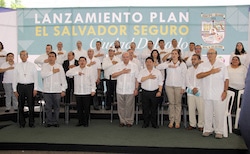While it is a laudable first step, the launch of a new security strategy in El Salvador will bring little improvement if the resources and political will aren’t there to implement it.
On July 16, El Salvador’s National Council on Citizen Security (CNSCC) officially launched “Secure El Salvador”: the government’s new security strategy aimed at confronting violence and criminality.
The plan — initially presented in January to President Salvador Sanchez Ceren — has five key objectives:
- Violence and crime prevention
- Improve the criminal justice system
- Inmate rehabilitation and reinsertion
- Attention and protection for victims
- Strengthen institutions responsible for citizen security.
To achieve these five objectives, the strategy includes 124 priority actions to be carried out over different time frames, ranging from six months to 10 years. The plan will initially focus on 50 municipalities before expanding further.
Ciudad Delgado — where the launch of the security strategy was held — will be the first municipality where the government will begin implementing the new plan. The citizen security council has named another nine municiplaities as top priorities.
Over the next five years, the plan is estimated to cost $2.1 billion — or 1.7 percent of GDP and 8.7 percent of the national budget (see table). Financing and investment are to come from the government, private sector, and international aid.

InSight Crime Analysis
The government’s new security strategy is a response to El Salvador’s deteriorating security situation. So far, 2015 has been extremely violent, with June reportedly registering the most homicides (677) of any month since the end of the country’s bloody civil war.
While defining a coherent security strategy is an important first step, implementing it effectively is where the true challenge lies — and it is an area where El Salvador has a poor track record.
SEE ALSO: Coverage of Security Policy
Indeed, it is worth questioning the government’s ability to harness the necessary resources and political will to enact these reforms. Some observers have said the government’s new strategy is simply recycling old ideas that have already proven ineffective.
Nonetheless, regardless of how good “Secure El Salvador” may look on paper, it will be worthless in practice if it is inadequately or half-heartedly put to work.

